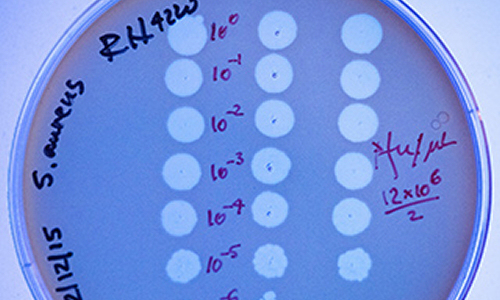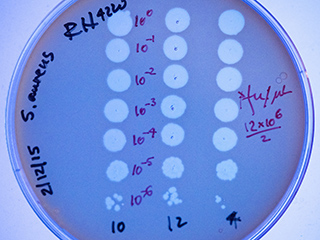Bacteria may not have brains, but they do have memories, at least when it comes to viruses that attack them. Many bacteria have a molecular immune system which allows these microbes to capture and retain pieces of viral DNA that they have encountered in the past, in order to recognize and destroy it when it shows up again.
CRISPR systems allow bacteria to adapt to new viral threats. Above, Staphylococcus aureus microbes lacking a CRISPR system are killed off by the bacteria-attacking virus ϕNM4. This plate approximates the concentration of virus particles used in the recent experiments.
Research at Rockefeller University described Wednesday (February 18) in Nature offers new insight into the mysterious process by which this system works to encode viral DNA in a microbe’s genome for later use as guides for virus-cutting enzymes.
“Microbes, like vertebrates, have immune systems capable of adapting to new threats. Cas9, one enzyme employed by these systems, uses immunological memories to guide cuts to viral genetic code. However, very little is known about how these memories are acquired in the first place,” says Assistant Professor Luciano Marraffini, head of the Laboratory of Bacteriology. “Our work shows that Cas9 also directs the formation of these memories among certain bacteria.”
These memories are embedded in the bacterial equivalent of an adaptive immune system capable of discerning helpful from harmful viruses called a CRISPR (clustered regularly interspaced short palindromic repeats) system. It works by altering the bacterium’s genome, adding short viral sequences called spacers in between the repeating DNA sequences. These spacers form the memories of past invaders. They serve as guides for enzymes encoded by CRISPR-associated genes (Cas), which seek out and destroy those same viruses should they attempt to infect the bacterium again.
Cas9’s ability to make precision cuts within a genome – viral or otherwise – has caught the attention of researchers who now use it to alter cells’ genetics for experimental or therapeutic purposes. But it is still not well understood just how this CRISPR system works in its native bacteria.
Some evidence suggested that other Cas enzymes managed the memory-making process on their own, without Cas9. But because of the way Cas9 goes about identifying the site at which to make a cut, the researchers, including co-first authors Robert Heler, a graduate student, and Poulami Samai, a postdoc in the lab, suspected a role for Cas9 in memory making.
In addition to matching its CRISPR guide sequence up with the DNA of the virus, Cas9 needs to find a second cue nearby: a PAM (protospacer adjacent motif) sequence in the viral DNA. This is a crucial step, since it is the absence of a PAM sequence that prevents Cas9 from attacking the bacterium’s own memory-containing DNA.
“Because Cas9 must recognize a PAM sequence before cutting the viral DNA, it made sense to us that Cas9 would also recognize the PAM sequence when the system is forming a memory of its first encounter with a virus,” Heler says. “This is a new and unexpected role for Cas9.”
To test their hypothesis, Heler swapped the Cas9 enzymes between the immune systems of Streptococcus pyogenes and Streptococcus thermophilus, each of which recognizes a different PAM sequence. As a result, the PAM sequences followed, swapping between the two bugs – evidence that Cas9 is responsible for identifying the PAM during memory formation. In another experiment, he altered the part of Cas9 that binds to the PAM sequence, and found the microbes then began acquiring the target viral sequences randomly, making them unusable.
Samai, meanwhile, looked at the relationship between Cas9 and three other Cas enzymes: Cas1, Cas2 and Csn2. Components of the same CRISPR system, these enzymes were already suspected to play a role in memory making without help from Cas9.
Samai expressed these enzymes together, then tagged each one and attempted to purify it. But each time, the other three came out as well. “This indicates there is some kind of interaction between the four; most likely they form a complex during the acquisition of memory,” she says.
“Because of its importance to biotechnology, Cas9’s has attracted a great deal of interest for its action targeting and cleaving viral genomes. Our work reveals an overlooked role for Cas9: forming the memories that make adaptive immunity possible for bacteria,” Marraffini says.
Story Source:
The above story is based on materials provided by Rockefeller University.






